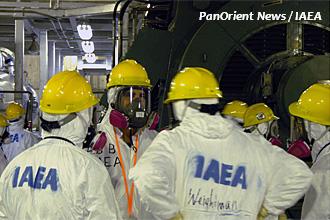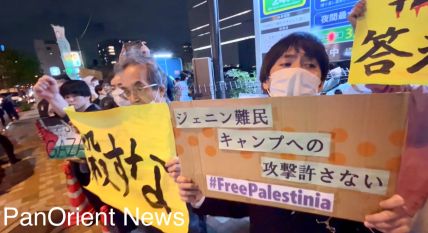|
|
Environment
Full Text of IAEA Expert Report on Japan's Worst Nuclear Crisis
Saturday, June 4, 2011

Tokyo- (PanOrient News) A group of experts from the International Atomic Energy Agency on a fact-finding mission into Japan's worst nuclear accident, triggered by the massive March 11 earthquake and tsunami, issued their report on the result of their inspection of the crippled Fukushima Daiichi power plant in northeastern Japan.
They said the risks of tsunami were underestimated as "these tsunami waves overwhelmed the defences of TEPCO`s Fukushima Dai-ichi facility, which were only designed to withstand tsunami waves of a maximum of 5.7 meters high."
This is the full report issued by IAEA and handed to the Japanese government on Wednesday:
INTERNATIONAL FACT FINDING EXPERT MISSION OF THE ACCIDENT FOLLOWING THE GREAT EAST JAPAN EARTHQUAKE AND
IAEA EXPERT MISSION TO JAPAN PRELIMINARY SUMMARY
1 JUNE 2011
The Great East Japan Earthquake on 11 March 2011, a magnitude 9 earthquake, generated a series of large tsunami waves that struck the east coast of Japan, the highest being 38.9 meters at Aneyoshi, Miyako.
The earthquake and tsunami waves caused widespread devastation across a large part of Japan, with more than 14,000 lives lost. In addition to this, at least 10,000 people remain missing, with many more being displaced from their homes as towns and villages were destroyed or swept away. Many aspects of Japan’s infrastructure have been impaired by this devastation and loss.
As well as other industries, several nuclear power facilities were affected by the severe ground motions and large multiple tsunami waves: Tokai, Higashi Dori, Onagawa, and TEPCO`s Fukushima Dai-ichi and Dai-ni. The operational units at these facilities were successfully shutdown by the automatic systems installed as part of the design of the nuclear power plants to detect earthquakes. However, the large tsunami waves affected all these facilities to varying degrees, with the most serious consequences occurring at TEPCO`s Fukushima Dai-ichi.
Although all off-site power was lost when the earthquake occurred, the automatic systems at TEPCO`s Fukushima Dai ichi successfully inserted all the control rods into its three operational reactors upon detection of the earthquake, and all available emergency diesel generator power systems were in operation, as designed. The first of a series of large tsunami waves reached the TEPCO`s Fukushima Dai-ichi site about 46 minutes after the earthquake.
These tsunami waves overwhelmed the defences of TEPCO`s Fukushima Dai-ichi facility, which were only designed to withstand tsunami waves of a maximum of 5.7 meters high. The larger waves that impacted this facility on that day were estimated to be larger than 14 meters high. The tsunami waves reached areas deep within the units causing the loss of all power sources except for one emergency diesel generator (6B), with no other significant power source available on or off the site, and little hope of outside assistance.
The station blackout at TEPCO`s Fukushima Dai-ichi and impact of the tsunami rendered the loss of all instrumentation and control systems at reactors 1-4, with emergency diesel 6B providing emergency power to be shared between Units 5 and 6. The tsunami and associated large debris caused widespread destruction of many buildings, doors, roads, tanks and other site infrastructure at TEPCO`s Fukushima Dai-ichi, including loss of heat sinks. The operators were faced with a catastrophic, unprecedented emergency scenario with no power, reactor control or instrumentation, and in addition to this, severely affected communications systems both within and external to the site. They had to work in darkness with almost no instrumentation and control systems to secure the safety of six reactors, six associated fuel pools, a common fuel pool, and dry cask storage facilities.
With no means to control or cool the reactor units, the three reactor units at TEPCO’s Fukushima Dai-ichi that were operational up to the time of the earthquake quickly heated up due to usual reactor decay heating. Despite the brave and sometimes novel attempts of the operational staff to restore control and cool the reactors and spent fuel, severe damage of the fuel and a series of explosions occurred. These explosions caused further destruction at the site, making the scene faced by the operators even more demanding and dangerous. Moreover, radiological contamination spread into the environment. These events are provisionally determined to be of the highest rating on the International Nuclear Event Scale.
To date no health effects have been reported in any person as a result of radiation exposure from the nuclear accident.
By agreement with the Government of Japan, the International Atomic Energy Agency conducted a preliminary mission to find facts and identify initial lessons to be learned from the accident at TEPCO’s Fukushima Dai-ichi and promulgate this information across the world nuclear community. To this end, a team of experts undertook this fact finding mission from 24 May to 1 June 2011. The results of this mission will be reported to the IAEA Ministerial Conference on Nuclear Safety at IAEA headquarters in Vienna from 20-24 June 2011. This is a preliminary summary report to provide immediate feedback to the Government of Japan.
During the IAEA mission, the team of nuclear experts received excellent co-operation from all parties, receiving information from many relevant Japanese ministries, nuclear regulators and operators. The mission also visited three affected nuclear power facilities – Tokai, TEPCO’s Fukushima Dai-ni and Dai-ichi to gain an appreciation of the status of the plant and the scale of the damage. The facility visits allowed the experts to talk to the operator staff as well as to view the on-going restoration and remediation work.
The mission gathered evidence, undertook a preliminary assessment and has developed preliminary conclusions as well as lessons to be learned. These preliminary conclusions and lessons have been shared and discussed with Japanese experts and officials. They fall broadly under the three specialist areas of external hazards, severe accident management and emergency preparedness. They are of relevance to the Japanese nuclear community, the IAEA and for the worldwide nuclear community to learn lessons to improve nuclear safety.
The main preliminary findings and lessons learned are:
· The Japanese Government, nuclear regulators and operators have been extremely open in sharing information and answering the many questions of the mission to assist the world in learning lessons to improve nuclear safety.
· The response on the site by dedicated, determined and expert staff, under extremely arduous conditions has been exemplary and resulted in the best approach to securing safety given the exceptional circumstances. This has been greatly assisted by highly professional back-up support, especially the arrangements at J-Village to secure the protection of workers going on sites.
· The Japanese Government’s longer term response to protect the public, including evacuation, has been impressive and extremely well organized. A suitable and timely follow-up programme on public and worker exposures and health monitoring would be beneficial.
· The planned road-map for recovery of the stricken reactors is important and acknowledged. It will need modification as new circumstances are uncovered
and may be assisted by international co-operation. It should be seen as part of a wider plan that could result in remediation of the areas off site affected by radioactive releases to allow people evacuated to resume their normal lives. Thus demonstrating to the world what can be achieved in responding to such extreme nuclear events.
· The tsunami hazard for several sites was underestimated. Nuclear designers and operators should appropriately evaluate and provide protection against the risks of all natural hazards, and should periodically update these assessments and assessment methodologies in light of new information, experience and understanding.
· Defence in depth, physical separation, diversity and redundancy requirements should be applied for extreme external events, particularly those with common mode implications such as extreme floods.
· Nuclear regulatory systems should address extreme external events adequately, including their periodic review, and should ensure that regulatory independence and clarity of roles are preserved in all circumstances in line with IAEA Safety Standards.
· Severe long term combinations of external events should be adequately covered in design, operations, resourcing and emergency arrangements.
· The Japanese accident demonstrates the value of hardened on-site Emergency Response Centres with adequate provisions for communications, essential plant parameters, control and resources. They should be provided for all major nuclear facilities with severe accident potential. Additionally, simple effective robust equipment should be available to restore essential safety functions in a timely way for severe accident conditions.
· Hydrogen risks should be subject to detailed evaluation and necessary mitigation systems provided.
· Emergency arrangements, especially for the early phases, should be designed to be robust in responding to severe accidents.
The IAEA mission urges the international nuclear community to take advantage of the unique opportunity created by the Fukushima accident to seek to learn and improve worldwide nuclear safety.
PanOrient News
© PanOrient News All Rights Reserved.
|
|

